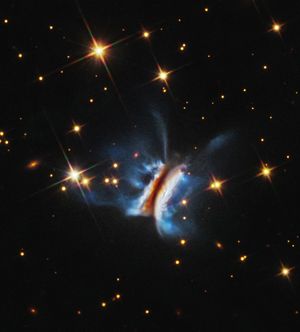NASA Hubble News
Here you will find Hubble's latest discoveries and its most recent images. You can also explore Hubble's archive of older image and science releases.
Search Hubble News
Type

Astronomers using NASA’s Hubble Space Telescope have imaged the largest protoplanetary disk ever observed circling a young star. For the…

This Hubble Space Telescope image shows the largest planet-forming disk ever observed around a young star. It spans nearly 400…

Image of Dracula's Chivito captured by Hubble's WFC3 instrument, with compass arrows, scale bar, and color key for reference.

A sideways spiral galaxy shines in this NASA/ESA Hubble Space Telescope image. Located about 60 million light-years away in the…

Like a game of cosmic bumper cars, scientists think the early days of our solar system were a time of…

This composite Hubble Space Telescope image shows the debris ring and dust clouds cs1 and cs2 around the star Fomalhaut.…

This artist’s concept shows the sequence of events leading up to the creation of dust cloud cs2 around the star…

Hubble captured the violent collision of two massive objects around the star Fomalhaut. This extraordinary event is unlike anything in…

This NASA/ESA Hubble Space Telescope image features a glittering blue dwarf galaxy called Markarian 178 (Mrk 178). The galaxy, which…

This NASA/ESA Hubble Space Telescope image features a stormy and highly active spiral galaxy named NGC 1792. Located over 50…

NASA’s Hubble Space Telescope reobserved interstellar comet 3I/ATLAS Nov. 30, with its Wide Field Camera 3 instrument. At the time,…

Today’s NASA/ESA Hubble Space Telescope image features the spiral galaxy NGC 4535, which is situated about 50 million light-years away…

This article was updated to include the full range of dates from the SOHO image. Lee esta historia en español…

Stars of all ages are on display in this NASA/ESA Hubble Space Telescope image of the sparkling spiral galaxy called…

This NASA/ESA Hubble Space Telescope image features a galaxy that’s hard to categorize. The galaxy in question is NGC 2775,…
Information
Media Resources
Need to talk to our communication's team? Need b-roll for the documentary your making? This page helps you find the Hubble media information you need.
Find Media Information about Media Resources



































Hubble
Social Media
These accounts represent NASA's Hubble Space Telescope on social media and follow the agency's policies and guidelines. Find the ones that match your interests and begin exploring!
Explore Social Media about Social Media